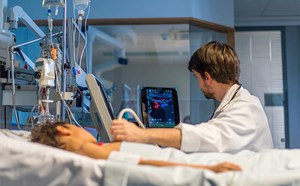
Probing the Literature National Journal Club
Petra Duran-Gehring, MD, FACEP
University of Florida CoM – Jacksonville,
@BoldCityUS
Roger Vazquez Gomez, MD
University of Florida CoM- Jacksonville,
Thomas Cox, MD
University of Florida CoM- Jacksonville
Andrea A. Segarra-Salcedo, MD
University of Florida CoM- Gainesville
The Probing the Literature National Journal Club is a joint endeavor between the ACEP Emergency Ultrasound Section and the SAEM Academy of Emergency Ultrasound and was created to fill a need in AEMUS Fellow education: to discuss current ultrasound literature, to learn from other researchers and to allow attendees to ask questions and share their research. Each month we cover a different topic via Zoom and each session consists of 3 components.
- Author Discussion: The first component is a discussion with an invited author regarding their article. Why did they choose this topic? What challenges did they face? What would they do differently if they could do the study again? The audience is encouraged to ask questions and this is a great opportunity for attendees to get insight into what it takes to create a successful research project. All Author Discussions are recorded and available to review on the ACEP EUS Youtube Channel.
- Small Group Session: We will then break out into small groups and discuss a second article, led by volunteer small group instructors.
- Methods Consult: Finally, at the end we have a methodology consultation session, where attendees can discuss their planned, current, or completed studies and receive targeted feedback from researchers and journal editors.
Check out what you may have missed at previous sessions with the following summaries created by current AEMUS fellows. We always love help from our community, so please contact us to see how you can get involved. We hope to see you at our next session,
ACEP/SAEM Probing the Literature: Ultrasound Journal Club Leadership Team
Petra Duran-Gehring, MD, FACEP
Michael Gottlieb, MD, FACEP
Nicole Duggan, MD
Monika Lusiak, MD, FACEP
Dan Mirsch, DO, FACEP
Nikolai Schnittke, MD
Sandy Werner, MD, MA, FACEP
Probing the Literature, November 15, 2022: Pediatric US
Guest Speaker: Dr. Stephanie Cohen, Emory University
Summary: Dr. Roger Vazquez Gomez, University of Florida- Jacksonville
Cohen SG, Malik ZM, Friedman S, Russell S, Hagbom R, Alazraki A, McCracken CE, Figueroa J, Adisa OA, Mendis RD, Manoranjithan S, Simon HK, Morris CR. Utility of Point-of-Care Lung Ultrasonography for Evaluating Acute Chest Syndrome in Young Patients With Sickle Cell Disease. Ann Emerg Med. 2020 Sep;76(3S):S46-S55. doi: 10.1016/j.annemergmed.2020.08.012. PMID: 32928462.
We were honored to have Dr. Stephanie Cohen as our guest speaker to present her research “Utility of Point-of-Care Lung Ultrasound for Evaluating Acute Chest Syndrome in Young Patients with Sickle Cell Disease (SCD),” published in the Annals of Emergency Medicine, September 2020. Dr. Cohen became interested in this topic because previous studies looking at physical examination of patients with acute chest syndrome were very nonspecific, identifying only 50% of affected patients. Chest X-ray has become the gold standard to diagnose this disease by identifying new lung infiltrates, but children with SCD can have >25 chest x-rays by age 18 and about 5% receive >100 chest x-rays, leading to a significant cumulative radiation. Dr. Cohen’s question then became, can lung ultrasound accurately diagnose acute chest syndrome and diminish the exposure to radiation in patients with SCD?
This study was performed at Children’s Healthcare of Atlanta, one of the largest SCD centers in the US with a prevalence of acute chest syndrome of 17%. As an academic center with physicians’ US experience ranging from novice to expert, it was the perfect clinical setting to evaluate the accuracy of diagnosing acute chest syndrome with POCUS in all ranges of sonographer experience. Her research primary aim was to determine the accuracy of POCUS to identify an infiltrate suggestive of acute chest syndrome in patients with SCD compared to chest x-ray with a secondary aim of evaluating the performance of novice sonographers and patient satisfaction.
This was a prospective observational study performed in 2 pediatric emergency departments. Patients with any genotype of SCD, aged 0 to 21, and who received chest radiography for evaluation of acute chest syndrome were included. Exclusion criteria included patents who required critical care and if they had previously known chest x-ray. A study sonographer blinded to physical exam and chest radiographic findings performed lung POCUS then parents/guardians completed a satisfaction survey on their experience.
As previous studies on lung ultrasound were performed by expert sonographers, Dr. Cohen wanted to assess the accuracy of lung ultrasound for acute chest syndrome by utilizing novice sonographers and an expert sonographer reviewer. All sonographers performed a 1-hour lung ultrasound training and novice sonographers performed 5 proctored lung POCUS before enrolling patients in the study. The scanning technique followed a standardized protocol with scanning of the anterior, lateral, and posterior lung fields in transverse and longitudinal orientations.
191 SCD patients were enrolled with a mean age of 8 years-old and a 17% prevalence of acute chest syndrome, demonstrating 92% accuracy of lung POCUS in detecting acute chest syndrome with a sensitivity of 92% and specificity of 93% when compared with chest x-ray. When comparing the expert sonographer review with the novice sonographers’ interpretation the sensitivity was lower than expected at 81% for the novice sonographer interpretation, but both interpretations had a similar negative predictive value of 97 and 96, respectively. There was a 93% patient satisfaction with care and many even said that it enhanced their visit to the emergency department.
Moreover, the study had 11 false positives (+POCUS, - CXR), which Dr. Cohen attributes to lung scarring, as most SCD patients with previous episodes of acute chest syndrome have chronic lung disease, and initially her team did not consider how lung scarring might appear on POCUS. There were also 4 false negatives, 3 of which were misinterpretations from novice sonographers that were picked up on blinded review and 1 that had consolidation was not picked up at all on ultrasound. Curiously, 3 of these patients with initially false negative interpretation developed acute chest syndrome during their admission. So, her team started to question whether lung POCUS could diagnose acute chest syndrome earlier than CXR and this is a topic that Dr. Cohen would like to investigate in the future. In conclusion, lung POCUS can detect acute chest syndrome in young patients with acute chest syndrome, is well tolerated and has high patient satisfaction.
Dr. Cohen concluded with some future research directions for peds lung pocus:
- Implementation of serial lung POCUS for admitted patients to avoid cumulative radiation of daily chest x-rays.
- Although using novice sonographers lends to the generalizability of the study, a multi-institutional study would validate the results further.
- Development of clinical algorithms on the use of lung POCUS in the emergency department are needed.
Dr. Cohen left us with some words of advice: do not give up in your research projects since sometimes research studies can be long. Initially, we can’t see the fruits of our labor, but it takes a little bit of time and effort until we can see our goals coming together.
Probing the Literature, January 17, 2023: Bowel US
Guest Speaker: Dr. Allison Cohen, Northshore University Hospital
Summary: Dr. Thomas Cox, University of Florida-Jacksonville
Cohen A, Li T, Stankard B, Nelson M. A Prospective Evaluation of Point-of-Care Ultrasonographic Diagnosis of Diverticulitis in the Emergency Department. Ann Emerg Med. 2020;76(6):757-66. doi: 10.1016/j.annemergmed.2020.05.017. Epub 2020 Jul 9. PMID: 32653332.
January’s Probing the Literature focused on bowel ultrasound with our special guest, Dr. Allison Cohen presenting her research “A Prospective Evaluation of Point-of-Care Ultrasonographic Diagnosis of Diverticulitis in the Emergency Department,” which was published in the Annals of Emergency Medicine, in July 2020. Dr. Cohen became interested in this topic after her ultrasound team started finding certain characteristics on educational ultrasound scans. She discovered that the literature on ultrasound for diverticulitis was scant, most being case studies from Europe, although some countries were already incorporating ultrasound as the diagnostic modality for diverticulitis. Dr. Cohen’s question then became, how good is ultrasound for the diagnosis of diverticulitis?
This prospective study conducted at a single center, investigated the test characteristics of point-of-care ultrasound for the diagnosis of diverticulitis in adult Emergency Department (ED) patients with suspected diverticulitis who received an abdominal CT. Primary outcome measures were sensitivity, specificity, positive predictive value, and negative predictive value. The estimated power calculation was 406 patients and the study enrolled 452 patients.
The ultrasonographers included ultrasound fellows, fellowship-trained emergency physicians, and physician assistants, all of whom had training in bowel ultrasound. The criteria for diverticulitis included all the following:
- The presence of diverticulum
- Local fatty enhancement
- Bowel wall edema > 5 mm
- Sonographic tenderness over the area
Using this set of criteria, this study found bowel ultrasound had a sensitivity of 92%, a specificity of 97%, a positive likelihood ratio of 30.7, and a negative likelihood ratio of .08. Therefore, POCUS should be considered in the diagnosis of diverticulitis as it has high sensitivity and specificity compared to CT.
Her team first trialed a small pilot program that quickly grew into a large prospective study. Dr. Cohen explains that having such robust ultrasound faculty, a large fellowship program, and buy-in from the faculty contributed to the success of meeting their enrollment goals. In the design of the study, Dr. Cohen and her team had to make important decisions on criteria. Prior literature on the topic of diverticulitis supported bowel wall edema measurements of both >4 mm and >5 mm. Ultimately, her team choose >5 mm to favor more specificity but explains that a future project may incorporate >4 mm to investigate if it can improve sensitivity. Another avenue of research she would like to investigate is how bowel ultrasound can be translated down to the resident-level ultrasonographer, which is a major limitation of this study.
Currently, she is working on a screening tool utilizing ultrasound imaging plus different patient parameters. She hopes the tool can be used to risk stratify uncomplicated diverticulitis from complicated diverticulitis and decrease CT scans in this population.
Dr. Cohen also gives us three great pearls of wisdom for accomplishing research. First, spend more time thinking about how you want to characterize data, generate fields, and collect variables at the beginning of the project. This type of downstream thinking will help build a better database in the beginning and avoid extra work later in the project. Second, if you have access to a statistician, use them early. They can help you with study design and data formatting, which will improve workflow efficiency. Lastly, don’t do everything yourself. You need a team because research is a team sport.
Probing the Literature, March 21, 2023: US Guided Nerve Blocks
Guest Speakers: Drs. Pete Croft, Dave Mackenzie, Christina Wilson, and Erik Christensen, Maine Medical Center
Summary: Dr. Andrea A. Segarra-Salcedo, University of Florida - Gainesville
Kring RM, Mackenzie DC, Wilson CN, Rappold JF, Strout TD, Croft PE. Ultrasound-Guided Serratus Anterior Plane Block (SAPB) Improves Pain Control in Patients With Rib Fractures. J Ultrasound Med. 2022;41(11):2695-701. doi: 10.1002/jum.15953. Epub 2022 Feb 2. PMID: 35106815.
This month we were joined by the Ultrasound Division at Maine Medical Center to discuss their paper “Ultrasound-Guided Serratus Anterior Plane Block (SAPB) Improves Pain Control in Patients With Rib Fractures,” published recently in the Journal of Ultrasound in Medicine in November 2022. They became interested in this topic as they wanted to study nerve blocks in the ED which led them to ask, does the SAPB decrease pain in patients with rib fractures in the ED?
This was a prospective, interventional study of a convenience sample of patients with at least two unilateral rib fractures, admitted for pain control at a single tertiary referral/ level I trauma center, who received the serratus anterior plane block (SAPB) in the ED. Six emergency medicine physicians (3 senior residents, 2 ultrasound fellows, and 1 attending physician) completed a 1 hour didactic and hands-on training session on performing the SAPB under ultrasound guidance and were eligible to enroll patients in the study.
20 adult patients were enrolled in the study. Prior to intervention, patients were asked to report their chest wall pain on the 11-point Numeric Rating Scale (no pain, 0-10 maximal pain), then were provided with an incentive spirometer (IS) and instructed in its use. Patients then received an ultrasound-guided SAPB by a study team member. Pain scale was then measured at 15 and 60 minutes post intervention at rest and during IS. Patients were monitored over the next 24 hours for post SAPB complications, including signs of local anesthetic systemic toxicity (LAST).
Pain improved over time with a reduction in the mean pain score, by 1.8 and 2.5 at 15 and 60 minutes respectively. Pain improved during IS as well, with a 1.95 and 2.4 reduction in mean pain scores at 15 and 60 minutes. Mean maximum vital capacity on IS after the SAPB was performed also increased by 232ml, demonstrating the effectiveness of the block. Zero SAPB-attributable complications were identified in the 24 hours post-enrollment. Therefore, SAPB decreased pain and improved IS measurements in patients with multiple rib fractures.
Although this study was initially attempting to enroll >60 patients, time constraints prevented the team from achieving that number. As SAPB targets anterior and lateral rib fractures, the authors reflect that they could not include patients with posterior rib fractures. Including the option of doing an Erector Spinae Plane (ESP) block for posterior rib fractures would have been useful to achieve their initial number of patients. Furthermore, Dr. Mackenzie noted that the patient’s initial pain score may be in the mid-range of the scale (5-6), therefore, reduction in the pain the patient experienced via the scale may not appear large due to the starting point. Prehospital opioids given prior to nerve blockade can also confound numerical pain reduction. On the other hand, patient satisfaction may be a better measure of the improvement in pain after the nerve block.
Drs. Croft, Wilson and Mackenzie offer the following advice:
- Collaboration with people outside of EM, such as the admitting team, can help with data collection in your study but can also improve interdepartmental relations, while improving patient care.
- Patient enrollment can be a time-consuming process in prospective studies and can limit numbers enrolled.
- IRB approval can be difficult when performing research involving medications and procedures, be prepared to answer questions and adjust your protocol accordingly, including questions of funding and storage of medications used.



